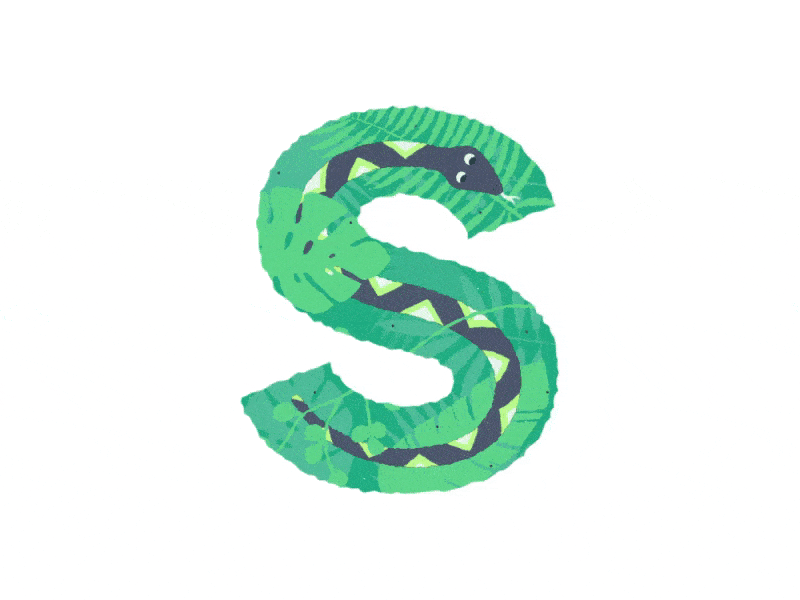

Silly Snake Called S
Emergent Literacy
Beatrice Smith
Rationale: This lesson will help children identify /s/, which is the phoneme represented by S. Students will learn to recognize /s/ in spoken words by learning a sound analogy (a hissing snake) and a hand motion. Students will learn the letter symbol S, practice finding /s/ in words, and apply phoneme awareness with /s/ in phonetic cue reading.
Materials:
Primary paper
Pencils
Crayons/colored pencils
Chart with “The silly snake likes to see sunsets”
Cards with the words: HOME, SLEEP, DEER, PENS, CASH, HUG, SALT, SAT, SEE, BUS, STOOL
Book: Scaredy Squirrel
Worksheet
Procedures:
-
Say: Our written language is a secret code and the tricky part about this code is learning what letters stand for, the way our mouthes move as we say words. Today we’re going to work on spotting the mouth move for /s/. We spell /s/ with the letter S. S looks like a slithering snake and /s/ sounds like a the snake is hissing.
-
Say: Let’s pretend we are snakes. Put your hands together and move them from side to side like a slithering snake [pantomime a slithering snake]. Now let’s hiss like snakes /s/ /s/ /s/. Notice what your mouth is doing [touch teeth]. When we say /s/ our teeth come together and we blow air out of mouthes.
-
Say: Let me show you how to find /s/ in the word horse. We are going to say it slowly so that we can hear hissing snake /s/. hhh-ooorrr-sss-eee. Did you hear the snake hiss? Let’s say it really slowly hhhhh-ooooo-rrrrr-sssss-eeeee. There it is! I felt my teeth come together as I blew air out! I can feel my hissing snake in horse.
-
Say: Let’s try saying a funny sentence called a tongue tickler. First I will tell you a story about this tongue tickler. There once was a little snake that would slither through the forest. He stayed in the shade because the sun was so hot, but he really liked the sun. He wanted to see he sun so in the evening he'd go outside. Alright so I’ll say it first and then we’ll all say it together. Whenever you hear /s/ show me by using your hands to slither like a snake: “The silly snake likes to see sunsets”. Let’s say it again, but this time stretch out the /s/ in the words: “The sssilly sssnake likesss to sssee sssunsssetsss”. Now we’re going to try it again and this time we’re going to break /s/ off the word: “The /s/ illy /s/ nake like /s/ to /s/ ee /s/ un /s/ et /s/”.
-
[Have students take out primary paper and pencil]. Say: We use letter S to spell /s/. Capital S looks like a big, sneaky snake. Let’s practice writing capital S. We’re going to put the head of our snake S at the rooftop and then curve it going down the left to make our first hump. Then at the fence we’re going to make another hump going to the right and ending at the sidewalk. You try it! After I put a smiley face next to it, please write it three more times. [After the capital S has been written] Now we’re going to try lowercase s. We’re going to do the same thing that we did for the capital S, except the head of the snake is at the fence. You make a small curve to the left and then a small curve to right, finishing with the tail at the sidewalk. Give it a try! After I put a smiley face next to your lowercase s, write it three more times.
-
Say: Now we’re going to play a game! For this game, you need to listen for the hissing snake /s/ in two words and try to figure out which one has the letter S in it. Do you hear /s/ in Sally or Harry? Do you hear /s/ in rainbow or sunshine? Do you hear /s/ in moose or duck? Great job! Now we are going to play another game! For this game I want you to slither your snake with your hands if you see the letter S on these word cards. [Hold up one card at a time]. *HOME, SLEEP, DEER, PENS, CASH, HUG, SALT* You all did a great job identifying the letter S!
-
Give a book talk for “Scaredy Squirrel” by Melanie Watt. Say: There is a squirrel who is a very nervous little guy. He loves staying in his nice, cozy tree all day. The world was too scary to him. But then one day he accidentally leaves his tree! He’s in the scary world! Let’s find out what happens to him! Whenever you hear me make the /s/ sound move your hands like a slithering snake.
-
Show SAD and model how to decide if it is sad or mad. Say: The S reminds me of our slithering snake so I know that letter sounds like /s/ which means that the word is sad. Now it’s your turn. *SAT*: sat or mat? *SEE*: see or tree? *BUS* bus or bug? *STOOL* stool or pool?
-
Assessment: [Pass out the worksheet and have the students get out crayons or colored pencils]. For this worksheet you have to color the things that start with S. As this is being done call students over one at a time to read the phonetic cue words in Step 8.
Sources:
Reference: Bolton, Olivia. “Slithering Snake with S”
https://ojb0003.wixsite.com/mysite-2/emergent-literacy
Murray, Bruce “Brush Your Teeth with F”
https://murraba.wixsite.com/lessondesigns2018/emergent-literacy
Book: “Scaredy Squirrel” By Melanie Watt: https://www.youtube.com/watch?v=dc4IJjFFdpg
Worksheet: https://www.superteacherworksheets.com/phonics-beginningsounds/letter-s_WFNND.pdf?up=1466611200
Image: https://dribbble.com/shots/4506878-S-N-A-K-E-36-Days-of-Type